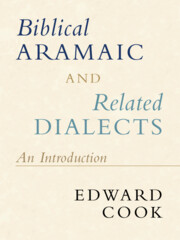Refine search
Actions for selected content:
36901 results in Cambridge Textbooks

Biblical Aramaic and Related Dialects
- An Introduction
-
- Published online:
- 08 September 2022
- Print publication:
- 29 September 2022
-
- Textbook
- Export citation
5 - Survey Research
-
- Book:
- The Fundamentals of Social Research
- Published online:
- 07 October 2022
- Print publication:
- 08 September 2022, pp 86-98
-
- Chapter
- Export citation
Index
-
- Book:
- A Stata Companion for <i>The Fundamentals of Social Research</i>
- Published online:
- 29 September 2022
- Print publication:
- 08 September 2022, pp 80-82
-
- Chapter
- Export citation
Contents
-
- Book:
- An SPSS Companion for <i>The Fundamentals of Social Research</i>
- Published online:
- 23 September 2022
- Print publication:
- 08 September 2022, pp vii-ix
-
- Chapter
- Export citation
3 - Evaluating Causal Relationships
-
- Book:
- The Fundamentals of Social Research
- Published online:
- 07 October 2022
- Print publication:
- 08 September 2022, pp 46-64
-
- Chapter
- Export citation
9 - Bivariate Hypothesis Testing
-
- Book:
- A Stata Companion for <i>The Fundamentals of Social Research</i>
- Published online:
- 29 September 2022
- Print publication:
- 08 September 2022, pp 45-56
-
- Chapter
- Export citation
4 - North India between Empires: History, Society, and Culture, 1350–1550
-
- Book:
- India before Europe
- Published online:
- 15 September 2022
- Print publication:
- 08 September 2022, pp 98-135
-
- Chapter
- Export citation
2 - The Art of Theory Building
-
- Book:
- An R Companion for <i>The Fundamentals of Social Research</i>
- Published online:
- 23 September 2022
- Print publication:
- 08 September 2022, pp 11-21
-
- Chapter
- Export citation
8 - Probability and Statistical Inference
-
- Book:
- An R Companion for <i>The Fundamentals of Social Research</i>
- Published online:
- 23 September 2022
- Print publication:
- 08 September 2022, pp 40-47
-
- Chapter
- Export citation
7 - Getting to Know Your Data
-
- Book:
- The Fundamentals of Social Research
- Published online:
- 07 October 2022
- Print publication:
- 08 September 2022, pp 114-130
-
- Chapter
- Export citation
2 - The Art of Theory Building
-
- Book:
- A Stata Companion for <i>The Fundamentals of Social Research</i>
- Published online:
- 29 September 2022
- Print publication:
- 08 September 2022, pp 11-19
-
- Chapter
- Export citation
3 - Regulatory Activities
-
- Book:
- Transnational Law
- Published online:
- 12 November 2022
- Print publication:
- 08 September 2022, pp 108-204
-
- Chapter
- Export citation
1 - Subject, Method, and Organization
-
- Book:
- Transnational Law
- Published online:
- 12 November 2022
- Print publication:
- 08 September 2022, pp 1-13
-
- Chapter
- Export citation
7 - Getting to Know Your Data
-
- Book:
- An R Companion for <i>The Fundamentals of Social Research</i>
- Published online:
- 23 September 2022
- Print publication:
- 08 September 2022, pp 32-39
-
- Chapter
- Export citation
11 - Multiple Regression
-
- Book:
- The Fundamentals of Social Research
- Published online:
- 07 October 2022
- Print publication:
- 08 September 2022, pp 201-245
-
- Chapter
- Export citation
5 - Survey Research
-
- Book:
- An R Companion for <i>The Fundamentals of Social Research</i>
- Published online:
- 23 September 2022
- Print publication:
- 08 September 2022, pp 28-28
-
- Chapter
- Export citation
4 - Research Design
-
- Book:
- A Stata Companion for <i>The Fundamentals of Social Research</i>
- Published online:
- 29 September 2022
- Print publication:
- 08 September 2022, pp 23-25
-
- Chapter
- Export citation
Preface
-
- Book:
- An SPSS Companion for <i>The Fundamentals of Social Research</i>
- Published online:
- 23 September 2022
- Print publication:
- 08 September 2022, pp xiii-xiv
-
- Chapter
- Export citation
Additional Bibliography
-
- Book:
- India before Europe
- Published online:
- 15 September 2022
- Print publication:
- 08 September 2022, pp 378-387
-
- Chapter
- Export citation
Index
-
- Book:
- India before Europe
- Published online:
- 15 September 2022
- Print publication:
- 08 September 2022, pp 388-395
-
- Chapter
- Export citation
